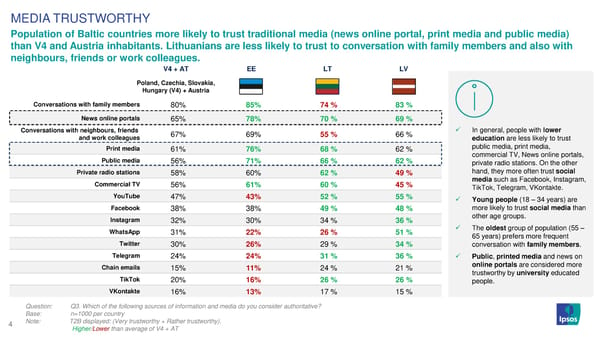MEDIATRUSTWORTHY Population of Baltic countries more likely to trust traditional media (news online portal, print media and public media) than V4 and Austria inhabitants. Lithuanians are less likely to trust to conversation with family members and also with neighbours, friends or work colleagues. V4 + AT EE LT LV Poland, Czechia, Slovakia, Hungary (V4) + Austria Conversations with family members 80% 85% 74 % 83 % Newsonlineportals 65% 78% 70 % 69 % Conversations with neighbours, friends 67% 69% 55 % 66 % ✓ In general, people with lower andworkcolleagues educationare less likely to trust Print media 61% 76% 68 % 62 % public media, print media, Public media 56% 71% 66 % 62 % commercial TV, News online portals, private radio stations. On the other Private radio stations 58% 60% 62 % 49 % hand, they more often trust social CommercialTV 56% 61% 60 % 45 % mediasuch as Facebook, Instagram, TikTok, Telegram, VKontakte. YouTube 47% 43% 52 % 55 % ✓ Young people (18 – 34 years) are Facebook 38% 38% 49 % 48 % more likely to trust social media than Instagram 32% 30% 34 % 36 % other age groups. WhatsApp 31% 22% 26 % 51 % ✓ The oldest group of population (55 – 65 years) prefers more frequent Twitter 30% 26% 29 % 34 % conversation with family members. Telegram 24% 24% 31 % 36 % ✓ Public, printed media and news on Chain emails 15% 11% 24 % 21 % online portals are considered more TikTok 20% 16% 26 % 26 % trustworthy by university educated people. VKontakte 16% 13% 17 % 15 % Question: Q3.Whichofthefollowing sources of information and media do you consider authoritative? Base: n=1000 per country Note: T2B displayed: (Very trustworthy + Rather trustworthy). 4 Higher/Lower than average of V4 + AT
 Perceptions of information chaos in Baltic states and Central Europe Page 3 Page 5
Perceptions of information chaos in Baltic states and Central Europe Page 3 Page 5